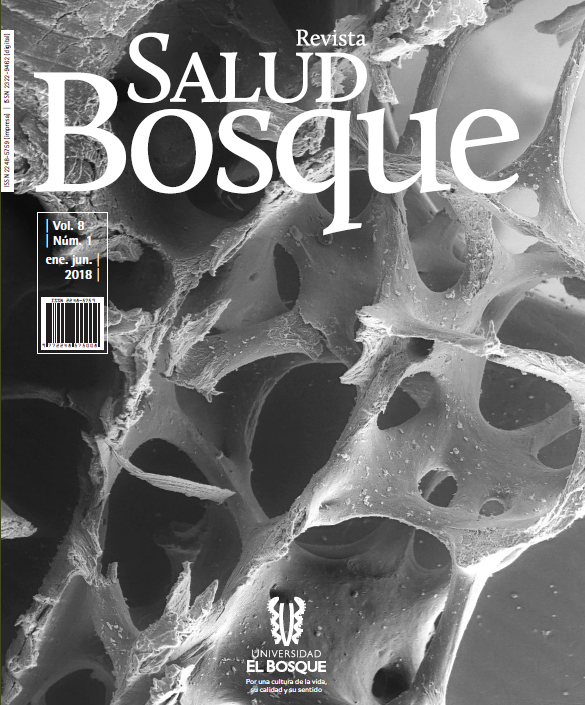Trombólisis
DOI:
https://doi.org/10.18270/rsb.v8i1.2379Palabras clave:
Terapia Trombolítica, Infarto agudo de miocardio, Accidente cerebrovascular, Tromboembolismo pulmonarResumen
En la homeostasis de un individuo sano se desarrollan coágulos para prevenir la pérdida de sangre, pero las fallas del equilibrio hemostático pueden ocasionar obstrucción aguda de una arteria como fenómeno fisiopatológico principal, que puede beneficiarse del tratamiento trombolítico que consiste en la administración, por vía endovenosa o en ocasiones intraarterial, de medicamentos capaces de destruir los coágulos de fibrina y permitir que se restaure el flujo sanguíneo en el vaso sanguíneo. Esto se hace para evitar complicaciones como infarto cerebral, embolia pulmonar, trombosis venosa profunda e infarto agudo del miocardio.
El siguiente documento es una revisión bibliográfica de la terapia fibrinolitica y su uso en estas entidades, teniendo en cuenta las recomendaciones de la Agency for Healthcare Research and Quality (AHRQ), usando PubMed como base datos de búsqueda principal. Se obtuvieron artículos sobre trombólisis en infarto agudo del miocardio, trombembolismo pulmonar y accidente cerebrovascular y según la pertinencia se procedió a su análisis para generar una recomendación.
Descargas
Referencias bibliográficas
Yusuf S, Collins R, Peto R, Furberg C, Stampfer MJ, Gol¬dhaber SZ, et al. Intravenous and intracoronary fibrino¬lytic therapy in acute myocardial infarction: Overview of results on mortality, reinfarction and side-effects from 33 randomized controlled trials..
Acierno LJ. The history of cardiology. New York: The Par¬thenon Publishing Group; 1994. ¿páginas?
Herrick JB. Clinical features of sudden obstruction of the coronary arteries. 2015-2020. JAMA. 1912;59:¿páginas?
DeWood M, Spores J, Notske R, Mouser L, Burroughs R, Golden M, et al. Prevalence of total coronary occlusion during the early hours of transmural myocardial infarction. N Engl J Med. 1980;303:897-902.
Tillett W, Garner R. The fibrinolytic activity of hemolytic streptococci. J Exp Med. 1933;58:485-502.
Sherry S, Tillett WS, Read CT. The use of stretokinase-streptodornase in the treatment of hemothorax. J Thorac Surg. 1950;20:393-417.
Sherry S, Fletcher A, Alkjaersigm N, Smyrniotis F. An ap¬proach to intravascular fibrinolysis in man. Trans Assoc Am Physicians. 1957;70:288-96.
Gruppo Italiano per lo Studio della Streptochinasi nell’Infarto Miocardico (GISSI). Effectiveness of intravenous throm¬bolytic treatment in acute myocardial infarction. Lancet. 1986;1:397-402.
Rijken DC, Collen D. Purification and characterization of the plasminogen activator secreted by human melanoma cells in culture. J Biol Chem. 1981;256:7035-41.
van de Werf F, Ludbrook PA, Bergmann SR, Tiefenbrunn AJ, Fox KA, de Geest H, et al. Coronary thrombolysis with tissue-type plasminogen activator in patients with evolving myocardial infarction. N Engl J Med. 1984;310:609-13.
GUSTO investigators. An international randomized trial comparing four thrombolytic strategies for acute myocar¬dial infarction. N Engl J Med. 1993;329:673-82.
Huynh T, Perron S, O’Loughlin J et al. Comparison of primary percutaneous coronary intervention and fibrino¬lytic therapy in ST-segment-elevation myocardial infarc¬tion: Bayesian hierarchical meta-analyses of randomized controlled trials and observational studies. Circulation. 2009;119:3101.
Pinto DS, Frederick PD, Chakrabarti AK et al. Benefit of transferring ST-segment-elevation myocardial infarction patients for percutaneous coronary intervention compared with administration of onsite fibrinolytic declines as delays increase. Circulation. 2011;23:2512-21.
O’Gara PT, Kushner FG, Ascheim DD, Casey DE Jr, et al. ACCF/AHA guideline for the management of ST-elevation myocardial infarction: executive summary: A report of the American College of Cardiology Foundation/American Heart Association Task Force on Practice Guidelines. Cir¬culation. 2013;127:485-510.
Thygesen K, Alpert JS, Jaffe AS, Simoons ML et al. Third universal definition of myocardial infarction. Circulation. 2012;126:2021-2033.
Ross AM, Coyne KS, Moreyra E, Reiner JS et al. Extended mortality benefit of early postinfarction reperfusion. Glo¬bal Utilization of Streptokinase and Tissue Plasminogen Activator for Occluded Coronary Arteries Trial. Circula¬tion. 1998;97:1549-1556.
Chareonthaitawee P, Gibbons RJ, Roberts RS et al. The impact of time to thrombolytic treatment on outco¬me in patients with acute myocardial infarction. Heart. 2000;88:352-356.
Boersma E, Maas AC, Deckers JW, Simoons ML. Early thrombolytic treatment in acute myocardial infarction: Re¬appraisal of the golden hour. Lancet. 1996;348:771-5.
Weaver WD, Cerqueira M, Hallstrom AP et al. Prehos¬pital-initiated vs hospital-initiated thrombolytic therapy. JAMA. 1993:270:1211-1216.
Steinberg JS, Hochman JS, Morgan CD et al. Effects of thrombolytic therapy administered 6 to 24 hours after myo¬cardial infarction on the signal-averaged ECG. Results of a multicenter randomized trial. Circulation. 1994;90:746-752
Rawles J, GREAT. 10 year survival of patients with sus¬pected acute myocardial infarction in a randomised com¬parison of prehospital and hospital thrombolysis. Heart. 2003;89:563-
Simoons M, Krzemiñska-Pakula M, Alonso A, Goodman S, Kali A, Loos U, et al. Improved reperfusion and clinical outcome with enoxaparin as an adjunct to streptokinase
thrombolysis in acute myocardial infarction. Eur Heart J. 2002;23:1282-90.
Tsang TS, Califf RM, Stebbins AL et al. Incidence and im¬pact on outcome of streptokinase allergy in the GUSTO-I trial. Global Utilization of Streptokinase and t-PA in Occlu¬ded Coronary Arteries. Am J Cardiol. 1997;79:1232-1235
Squire IB, Lawley W, Fletcher S. Humoral and cellular immune responses up to 7.5 years after administration of streptokinase for acute myocardial infarction. Eur Heart J. 1999;20:1245-1252.
Randomised trial of intravenous streptokinase, oral aspirin, both, or neither among 17,187 cases of suspected acute myocardial infarction: ISIS-2. ISIS-2 (Second International Study of Infarct Survival) Collaborative Group. Lancet, 1988;2:349-60.
Collen D. Lignen HR. Todd PA. Tissue - type plasminogen activator. A review of its pharmacology and therapeutic use as a thrombolityc agent. Drugs. 198938(3):346-388
GUSTO . Incidence and predictors of bleeding after con¬temporary thrombolytic therapy for myocardial infarction. Circulation.1997;95:2508-.
Gore JM, Granger CB, Simoons ML et al. Stroke after thrombolysis. Mortality and functional outcomes in the GUSTO-I trial. Global Use of Strategies to Open Occluded Coronary Arteries. Circulation. 1995; 92:2811-2818.
Global Use of Strategies to Open Occluded Coronary Ar¬teries (GUSTO III) investigators. A comparison of retepla¬se with alteplase for acute myocardial infarction. N Engl J Med.1997;337:1118-23.
Assessment of the Safety and Efficacy of a New Throm¬bolytic (ASSENT-2) investigators, van De Werf F, Adgey J, Ardissino D, Armstrong PW, Aylward P et al. Single-bolus tenecteplase compared with front-loaded alteplase in acu¬te myocardial infarction: the ASSENT-2 double-blind ran¬domised trial. Lancet. 1999;354:716-22.
The National Institute of Neurological Disorders, Stroke rt- PA Stroke Study Group. Tissue plasminogen activator for acute ischemic stroke. N Engl J Med. 1995;333:1581-7.
Kwiatkowski TG, Libman RB, Frankel M, Tilley BC, Mor¬genstern LB, Lu M, et al. Effects of tissue plasminogen ac¬tivator for acute ischemic stroke at one year. N Engl J Med. 1999;340:1781-7.
Marler JR, Tilley BC, Lu M, Brott TG, Lyden PC, Grotta JC, et al. Early stroke treatment associated with bet¬ter outcome: the NINDS rt-PA stroke study. Neurology. 2000;55:1649-55.
Hacke W, Kaste M, Bluhmki E, Brozman M, Dávalos A, Gui¬detti D, et al. Thrombolysis with alteplase 3 to 4.5 hours af¬ter acute ischemic stroke. N Engl J Med. 2008;359:1317-29.
Lees KR, Bluhmki E, von Kummer R, Brott TG, Toni D, Grotta JC, et al. Time to treatment with intravenous alte¬plase and outcome in stroke: An updated pooled analysis of ECASS, ATLANTIS, NINDS, and EPITHET trials. Lancet. 2010;375:1695-703.
Kearon C, Akl EA, Comerota AJ, Prandoni P, Bouna¬meaux H, Goldhaber SZ, et al. Antithrombotic therapy for VTE disease: Antithrombotic therapy and prevention of thrombosis, 9th ed: American College of Chest Physi¬cians Evidence-Based Clinical Practice Guidelines. Chest. 2012;141(Suppl):e419S-96.
Dong B, Jirong Y, Liu G, Wang Q, Wu T. Thrombolytic therapy for pulmonary embolism. Cochrane Database Syst Rev, CD004437. 2006.
Stein PD, Matta F. Therapy in unstable patients with acu¬te pulmonary embolism: saves lives but underused. Am J Med. 2012;15:465-
Stein PD, Matta F. Treatment of unstable pulmonary em¬bolism in the elderly and those with comorbid conditions. Am J Med. 2013;126:304-10.
Konstantinides S, Tiede N, Geibel A, Olschewski M, Just H, Kasper W. Comparison of alteplase versus heparin for resolution of major pulmonary embolism. Am J Cardiol. 1998;82:966-70.
Sharma GV, Burleson VA, Sasahara AA. Effect of throm¬bolytic therapy on pulmonary-capillary blood volume in patients with pulmonary embolism. N England J Med. 1980;303:842-5.
Sharma, GVRK, Folland, ED, McIntyre, KM. Long-term he¬modynamic benefit of thrombolytic therapy in pulmonary embolic disease. J Am Coll Cardiol. 1990;15:65A.
Jerjes-Sánchez C, Ramirez-Rivera A, de Lourdes M et al. Streptokinase and heparin versus heparin alone in massi¬ve pulmonary embolism: A randomized controlled crial. J Thromb Thrombolysis. 1995;2:227-229.
Dotter CT, Seamon AJ, Rosch J. Streptokinase and heparin in the treatment of acute pulmonary embolism. Vascular Surgery.1979;13:42-52
Ly B, Arnesen H, Eie H, Hol R. A controlled clinical trial of streptokinase and heparin in the treatment of major pulmo¬nary embolism. Acta Med Scand. 1978;203:465-70.
Tibbutt DA, Davies JA, Anderson JA et al. Comparison by con¬trolled clinical trial of streptokinase and heparin in treatment of life-threatening pulmonary embolism. BMJ. 1974;1:343-7.
Wan S, Quinlan DJ, Agnelli G, Eikelboom JW. Thrombo¬lysis compared with heparin for the initial treatment of pulmonary embolism: A meta-analysis of the randomized controlled trials. Circulation. 2004;110:744-9.
Kearon C, Akl EA, Comerota AJ, et al. Antithrombotic The¬rapy for VTE Disease: Antithrombotic Therapy and Pre¬vention of Thrombosis, 9th ed: American College of Chest Physicians Evidence-Based Clinical Practice Guidelines. Chest. 2012;141(2 Suppl):e419S-e494S.
Fiumara K, Kucher N, Fanikos J, Goldhaber SZ. Predictors of major hemorrhage following fibrinolysis for acute pul¬monary embolism. Am J Cardiol. 2006;97:127-9..
Gore JM. Prevention of severe neurologic events in the thrombolytic era. Chest. 1992;101(Suppl.4):124-30S.
Wechsler, LR. Intravenous Thrombolytic Therapy for Acute Ischemic Stroke. N Engl J Med 2011;364: 2138-2146
Ibanez B, James S, Agewall S et al. ESC Scientific Docu¬ment Group; 2017 ESC Guidelines for the management of acute myocardial infarction in patients presenting with ST-segment elevation: The Task Force for the management of acute myocardial infarction in patients presenting with ST-segment elevation of the European Society of Cardiology (ESC). European Heart Journal. 2018;39,119–177
Powers WJ, Derdeyn CP, Biller J et al. American Heart As¬sociation Stroke Council. 2015 AHA/ASA Focused Update of the 2013 Guidelines for the Early Management of Pa¬tients With Acute Ischemic Stroke Regarding Endovascular Treatment. Stroke. 2015;46:3020-3035
Kearon C, Akl EA, Omelas J, et al. Antithrombotic therapy for VTE disease: CHEST Guideline and Expert Panel Re¬port. Chest. 2016;149:315-52.
González F, Sáenz O, Manrique C, Rocha N, Miranda R, Pereira M, et al. Reanimación y cuidado intensivo en el servicio de urgencias. Acta Colombiana De Cuidado Inten¬sivo. 2013:10:166-72.
Descargas
Publicado
Cómo citar
Número
Sección
Licencia
El (Los) autor(es) certifican que es(son) el (los) autor(es) originario(s) del trabajo que se esta presentando para posible publicación en la Revista Salud Bosque de la Facultad Escuela Colombiana de Medicina de la Universidad El Bosque, puesto que sus contenidos son producto de su directa contribución intelectual.
Todos los datos y las referencias a materiales ya publicados deben estar debidamente identificados con su respectivo crédito e incluidos en las notas bibliográficas y en las citas que se destacan como tal y, en los casos que así lo requieran, deben contar con las debidas autorizaciones de quienes poseen los derechos patrimoniales.
El (Los) autor(es) declara(n) que todos los materiales que se presentan están totalmente libres de derecho de autor y, por lo tanto, se hace(n) responsable(s) de cualquier litigio o reclamación relacionada con derechos de propiedad intelectual, exonerando de responsabilidad a la Universidad El Bosque











